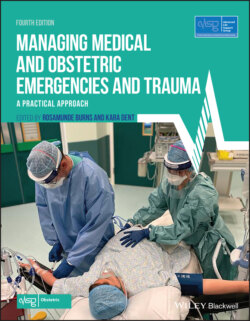Читать книгу Managing Medical and Obstetric Emergencies and Trauma - Группа авторов - Страница 98
6.1 Introduction
ОглавлениеShock is defined as a life‐threatening failure of adequate oxygen delivery to the tissues. If left untreated, shock results in sustained multiple organ dysfunction, end‐organ damage and death. It occurs when the cardiovascular response to systemic challenges such as blood loss or sepsis is inadequate.
Decreased blood perfusion of tissues, inadequate blood oxygen saturation or increased oxygen demand from the tissues result in failure of adequate oxygen delivery.
A reduction in cardiac output and a reduction in perfusion pressure will reduce the blood perfusion of tissues. Cardiac output is the product of stroke volume (the volume of blood pumped out of the heart with each beat) and heart rate.
Stroke volume is dependent on preload (filling status), cardiac contractility (pumping strength) and the afterload (vascular resistance – the resistance against which the myocardium has to pump). Shock may result if any of the these components are compromised.
During normal homeostasis, organ perfusion is regulated by local metabolic and microcirculatory factors within a set range of arterial pressures. This is called autoregulation. Beyond this range, blood flow to the organ is primarily determined by the pressure differential between the arterial and venous systems.
The blood supply to vital organs is maintained at lower blood pressures than that to non‐vital organs. In shocked states, blood is preferentially supplied to the brain and the heart at the expense of perfusion elsewhere. Unfortunately for the fetus, the uterus does not count as one of the woman’s vital organs, hence placental blood supply is not maintained in the presence of a life‐threatening challenge to the mother. The resulting fetal compromise is an early and important indicator of maternal shock.
